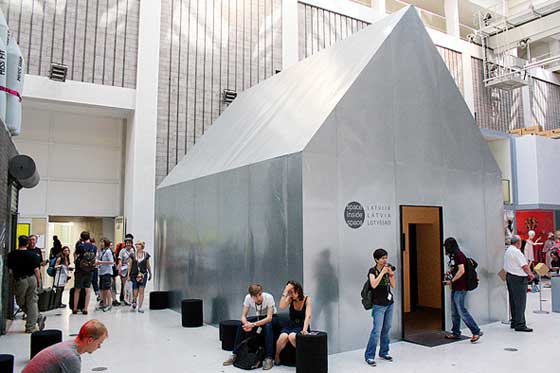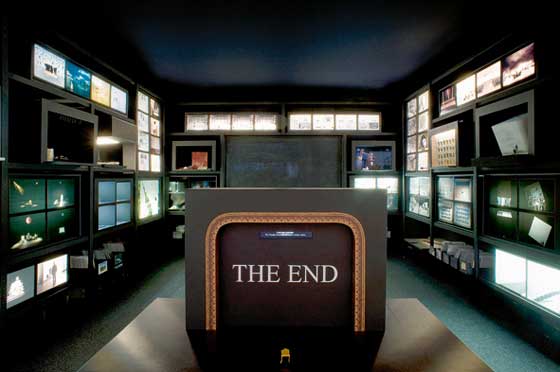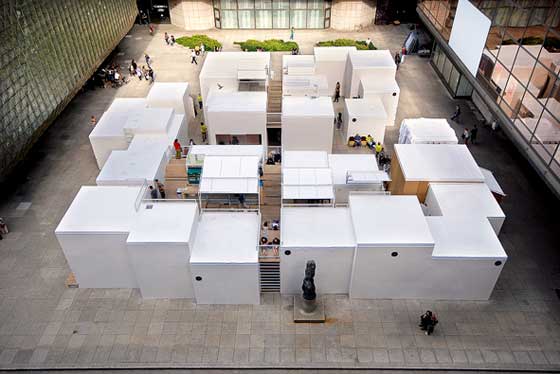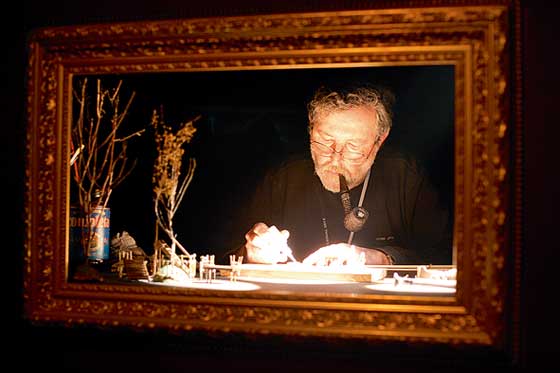|
|
| Point of interest Anita Vanaga, Art Historian Latvia at the Prague Quadrennial of Performance Design and Space 2011 | |
| The 12th Prague Quadrennial of Performance Design and Space 11 (PQ), an international competitive exhibition which took place at Veletržni Palace 16–26 June, drew 62 national expositions and more than 40 higher education institutions. The jury rated the exhibit by the scenography department students and lecturers of the Art Academy of Latvia as being worthy of a gold medal [as the Best Exhibit in the Student Section]. Latvia’s national stand at this year’s Quadrennial was devised by Reinis Suhanovs, who in 2007 was awarded a gold medal as the most promising young scenographer. For this Prague Quadrennial, Suhanovs created the Telpa telpā [‘Space within a Space’] installation, in close collaboration with composer Jēkabs Nīmanis, lighting artist Krišjānis Strazdītis and a technical team led by Oskars Plataiskalns. The participation of Latvia was enabled by the assistance of the New Theatre Institute of Latvia. | |
 Reinis Suhānovs. Space within a Space. Latvia's national exposition at the 12th Prague Quadrennial of Performance Design and Space | |
| Telpa Telpā [Space within a Space] The PQ 2011 put forward as the main question a rhetorical impasse: is it even possible to exhibit scenography? No! Because in real life scenography fertilizes an idea and becomes part of a greater whole. Many expositions had fallen into the trap of the impasse, and demonstrated video documentaries of productions which, due to the shortage of time and wealth of information, it wasn’t possible to take in. Yes! Because scenography conceives of the core, the seminal part. What is scenography today? Already in the 20th century, the key figure in theatre was considered to be the director. In Latvia’s case, scenography has often taken on directing functions and has worked as directorial scenography. It creates the performance concept, what the performance will be about and how it will develop, how visual art resources will be used and how the costume will help an actor create the character. Reinis Suhanovs, who after graduating from the Scenography Department at the Art Academy of Latvia is continuing his studies in directing at the Latvian Academy of Culture, is an adherent of this direction in scenography. In 2010 he received the highest accolade in Latvian theatre, the Spēlmaņu nakts [‘Players’ Night’] award, as Scenographer of the Year for the visual conception of Grigori Gorin’s play ‘Till Eulenspiegel’ (Director Mihails Gruzdovs, Daile Theatre). The Latvian national stand in Prague was in the form of a house with a tin-clad gabled roof. It contained four production models which had evolved in cooperation with director Viesturs Meikšāns: Plūdi un saulgrieži Straumēnu skaņās [‘Floods and Solstices to the Sounds of Straumēni’] from the poem Straumēni by Edvarts Virza; a play by Rainis, Zelta zirgs [‘Golden Horse’], where the idea of conquering oneself (or the glass mountain) was incarnated by the viewers of the performance who were being filmed; the production Marionetes based on Ingmar Bergman’s film ‘From the Life of the Marionettes’; and the 7 Fausti production based on Johann Wolfgang Goethe’s motifs, where the protagonist travels in time, using a wind rose for navigation, but the transparent glass acts as a wall that disappears every so often, indicating that one is being watched. Absolute evil has multiplied by division and become embodied in the lovable faces of two Teletubbies. The second most important part of the exposition was Reinis Suhanovs’ installation Telpa telpā, which developed and expanded on the Plūdi un saulgrieži Straumēnu skaņās performance concept. The metal exterior of the silver building turned out to be deceptive. “It was a black, coallike emptiness where the fatherland was!” But casting aside Rainis, in Straumēni everything was based on non-verbal communication; in the performance, the poet’s words were levelled to a stream of sound. The inside of the building, lined with burnt wood, was redolent of burning, smoked sprats, a sauna or maybe Jāņi. The burning reveals the fibre of the grain. In today’s Straumēni, Suhanovs raises as the flag of honour the birthmark of globalism – a satellite dish, the “autonomous sun” or “the landed heavens”, an element of reception. But in the dead space there’s also a transmitter, the living breath, the pattern of the passage of time. Something lights up in the space, it moves and can be heard. The bustling sound composition is by composer Jēkabs Nīmanis: “Little motors play. The symbolic annual cycle consists of eight periods, with solstices at both ends. There are ostinato themes, diatonic music in the traditional manner, but in between there are transitions, like autumn and spring. The composition is in fact linear, while retaining a cyclical concept which lasts 10, maybe 15 minutes. The music and lighting are synchronized: in the winter cycle there is blue light, in summer – yellow.” Experimenting with home-made mechanisms, the authors of the exposition created sounds using various sound objects. Skola skolā [School within a School] The Head of the Scenography Department at the Art Academy of Latvia, Professor Andris Freibergs, had placed the students’ work in an allegorical structure Skola. In the centre of the space, four benches were arranged one behind the other, at the front there was a board-screen, where we saw students who had been filmed writing vers libre drama sentences. Truth to be told, on opening day the screen was covered with enthusiastic responses from viewers which the professor wiped off by his own hand. The overarching task of the exposition was the portrayal of four playwrights: Shakespeare – Chekhov – Beckett – Blaumanis. The task was to find, in the writings of the four, conceptual interlinking motifs and units of meaning that overlap. Or, alternatively, to devise capacious visual structures outside the text which could be adapted for different performances. | |
 Student Section. Latvia. Gold Medal for Best Exhibit | |
| “What do Blaumanis and Beckett have in common, and what is different?” asks Viktors Jansons. “One thing in common could be the totally absurd. The second – details and materials which are used in scenography, for example, a tree. Beckett’s tree in ‘Waiting for Godot’ is one of the standards in set design. Is there a tree in Blaumanis? Blaumanis has ‘Indrāni’. There is a tree as well – Noliņš has burnt the apple tree – in the apple tree of Pazudušais dēls [‘Prodigal Son’] we find Beckett. Furthermore, Blaumanis has invented one of the world’s stages: the ice floe in Nāves ēnā [‘In the Shadow of Death’]. The writer places people he knows in the extreme situation of being stranded on an ice floe. How will they behave, what will happen with their interpersonal relationships? It transpires that Blaumanis is in close harmony with Beckett, because Blaumanis is, in essence, dealing with an absurd situation. Chekhov and Blaumanis, too, are equal partners. Absolutely. Contemporaries. Chekhov took into account that it wasn’t just the form of the performance, more staged or more realistic, that had an effect on a person’s psyche, but also nature that creates movements in the subconscious.” In Skola the audience was involved in a visual rebus guessing game and the recognition of situations using a “cheat sheet” – each student’s common denominator for the four authors could be read off printed cards. The exposition was created by Artūrs Arnis, Rūdolfs Baltiņš, Uģis Bērziņš, Reinis Dzudzilo, Linda Ekere, Sintija Jēkabsone, Liene Jonīte, Valters Kristbergs, Madara Lazdiņa, Katharina Maximoff (Austria), Ivars Noviks, Krista Ose, Ance Strazda, Maret Tamme (Estonia), Einārs Timma and Oskars Točs. Four interpretations of works by four authors in four mutually unified spaces is a complex undertaking. “The outcome of the exposition is like the first proposal that the scenographer shows to the director. To develop four positions from the one thing, and to obtain that particular touch of Chekhov or Shakespearean mood,” according to Freibergs. | |
 View of PQ 2011 section 'Intersection: Intimacy and Spactacle' | |
| Within the framework of terms proposed by Valters Kristbergs, Anton Chekhov’s ideal theatre ‘The Seagull’ elicited delight: Ņina Zarečnaja walking along the surface of the pool of water like Jesus Christ, Hamlet squatting among the salts remaining after the water has evaporated. Madara Lazdiņa’s variations on the columbarium: in Samuel Beckett’s ‘Endgame’ it was seen as a wall of urns, in Shakespeare’s ‘Hamlet’ it materialized in a gallery of family portraits, in Chekhov’s ‘The Cherry Orchard’ it became an ivy-covered garden hiding the presence of death. In Einārs Timma’s ‘Endgame’ three talking heads were mounted in the middle of a choir, in ‘Nāves ēnā’, a citation from the film by Gunārs Piesis was combined with people relaxing on a beach, in Ophelia’s mad scene from ‘Hamlet’ he quoted from a production of ‘Hamlet’ by Andris Freibergs, but the Chekhovian delicate troubles were contrasted with the hard working farmers. For Katharina Maximoff the departure point was an abundance of things and she had piled up the old man Indrāni father’s ash trees like alpine mountain ranges, but made Hamlet lose his way in a library. Artūrs Arnis saw in the hypostases of peat the Indrāni farmstead swamp with a petrol pump, but in ‘Endgame’, the blocks of peat began to talk. Ivars Noviks froze talking heads in the ‘Endgame’ refrigerator, while Maret Tamme chose a glass tunnel as her primary form, symbolizing at the same time both home and homelessness. In ‘King Lear’ she divided up a great mass of tunnel, cutting it up into chunks, but in ‘Nāves ēnā’ the glasshouse had transformed into a bright idea about a block of ice, into which the fishermen had been frozen. In actorless minimalism Oskars Točs sees the stage as an area for moving around antennas. How long can you watch theatre like this? “In theatre everything is possible, and through this, a new life and a new event. Students get used to the fact that theatre wipes away domestic life, realism,” summed up Freibergs. The exposition symbolically begins and ends with a model created by Reinis Dzudzilo: using the gilded proscenium arch from the stage of Latvian National Opera and a subtitling machine where one could read text, he had selected the title “The End” as the unifier – all performances eventually come to an end... | |
 Monika Pormale. Exhibit No.17. Installation, performance. 2011 | |
| Intersection: Intimacy and Spectacle Thanks to a suggestion by Monika Pormale (PQ11 jury member) and constructed according to a plan by Israeli architect Oren Sagiv, 30 white cubes had been set up in the courtyard between the National Theatre, the Prague Opera and the famous Laterna Magika Theatre building. In these, 30 artists had created expositions following the one set of rules. Pormale’s cube – glass showcase, in which, under the radiance of the sculpted ceiling glory, embracing took place, echoed a production based on Vladimir Sorokin’s novel ‘The Ice’ at New Rīga Theatre, and was the apotheosis of the cube settlement and a magnet for photo lens. In one of the cubes Dace Džeriņa, whose scenography is associated with directors Baņuta Rubesa and Ilze Olingere, exhibited her installation Ceļojošais deju skolotājs [‘Touring Dance Teacher’] – a tango dance step diagram and recording of music, but Rolands Pēterkops and Marīte Mastiņa, more commonly known as the creative tandem mareunrol’s, exhibited puppets in a costume, light and sound installation called Kaimiņš/Kustība bez nosaukuma [‘Tenant/Untitled movement’]. The installation Telpa telpā by Reinis Suhanovs will be on show in Rīga from 3 to 9 September, during the Homo Novus International Festival of Contemporary Theatre. /Translator into English: Uldis Brūns/ | |
| go back | |







